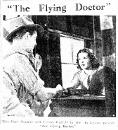AustLit
 5683620694228612154.jpg
5683620694228612154.jpg
Publicity still, Northern Star, 31 October 1936, p.4
Adaptation of
The Flying Doctor
1934
single work
novel
Issue Details:
First known date:
1936...
1936
The Flying Doctor
The material on this page is available to AustLit subscribers. If you are a subscriber or are from a subscribing organisation, please log in to gain full access. To explore options for subscribing to this unique teaching, research, and publishing resource for Australian culture and storytelling, please contact us or find out more.
Film Details - National Productions , 1936
Producers:
Miles Mander
Production Companies:
National Productions
Gaumont-British Picture Corporation
Director of Photography:
Dereck Williams
Editors:
J.O.C. Orron
R. Maslyn Williams
Edna Turner
Production Designers:
Richard Ridgway (Art Director)
Cast:
Incl. Charles Farrell (Sandy Nelson), Mary Maguire (Jenny Rutherford), James Raglan (Dr John Vaughan), Joe Valli (Dodger Green), Margaret Vyner (Betty Webb), Eric Colman (Geoffrey Webb), Tom Lurich (Blotch Burns), Maudie Edwards (Phyllis), Katie Towers (Mrs O'Toole), Phillip Lytton (Dr Gordon Rutherford), Andrew Beresford (John Rutherford), Jack Clarke (Pop Schnitzel), Phil Smith (Barman Joe), Don Bradman (himself), Frank Coughlan (himself - re: Frank Coughlan and the Trocadero Orchestra).
Release Dates:
21 August 1936 (Brisbane). Released by 20th Century Fox. Premiered in the UK in September 1937 (distributed by General Film Distributors).
Location:
- Sydney
Awards:
- Venice Film Festival (1936), Special Recommendation - Robert Mander (winner)
Notes:
1. The Flying Doctor's final production costs were officially announced as £35,000, but as Andrew Pike and Ross Cooper note, 'trade gossip suggested figures of around £45,000 (more than twice the cost of a Cinesound feature at that time).' Despite such a large budget, the film was heavily criticised by reviewers, who drew attention to its unconvincing storyline, its lack of dramatic organisation, and its over-sentimentality. The film was similarly received by the British film critics, and subsequently was never exhibited in the USA. Somewhat surprisingly, though, Mander was accorded special recognition at the 1936 Venice Film Festival.
2. Gaumont-British cut the film by some considerable length (approximately 25 minutes) and planned to release it as a supporting feature (despite strong protests by Mander and National Productions). The company eventually let go of its distribution rights for the UK and after a series of complex negotiations the film was screened by General Film Distributors.
3. Further reference: Andrew Pike and Ross Cooper. Australian Film 1900-1977, A Guide to Feature Film Production (1980), pp. 227-228.
Settings:
- Sydney, New South Wales,
- Bush,


